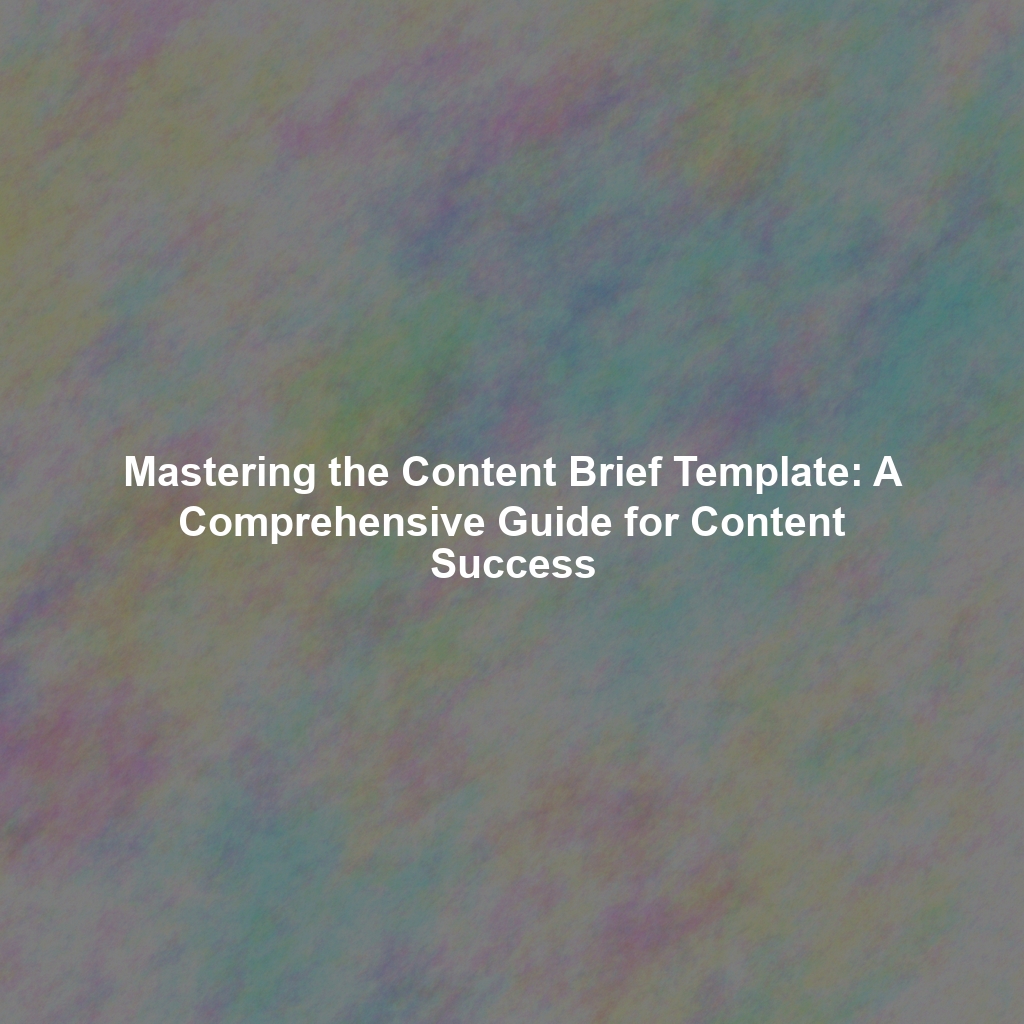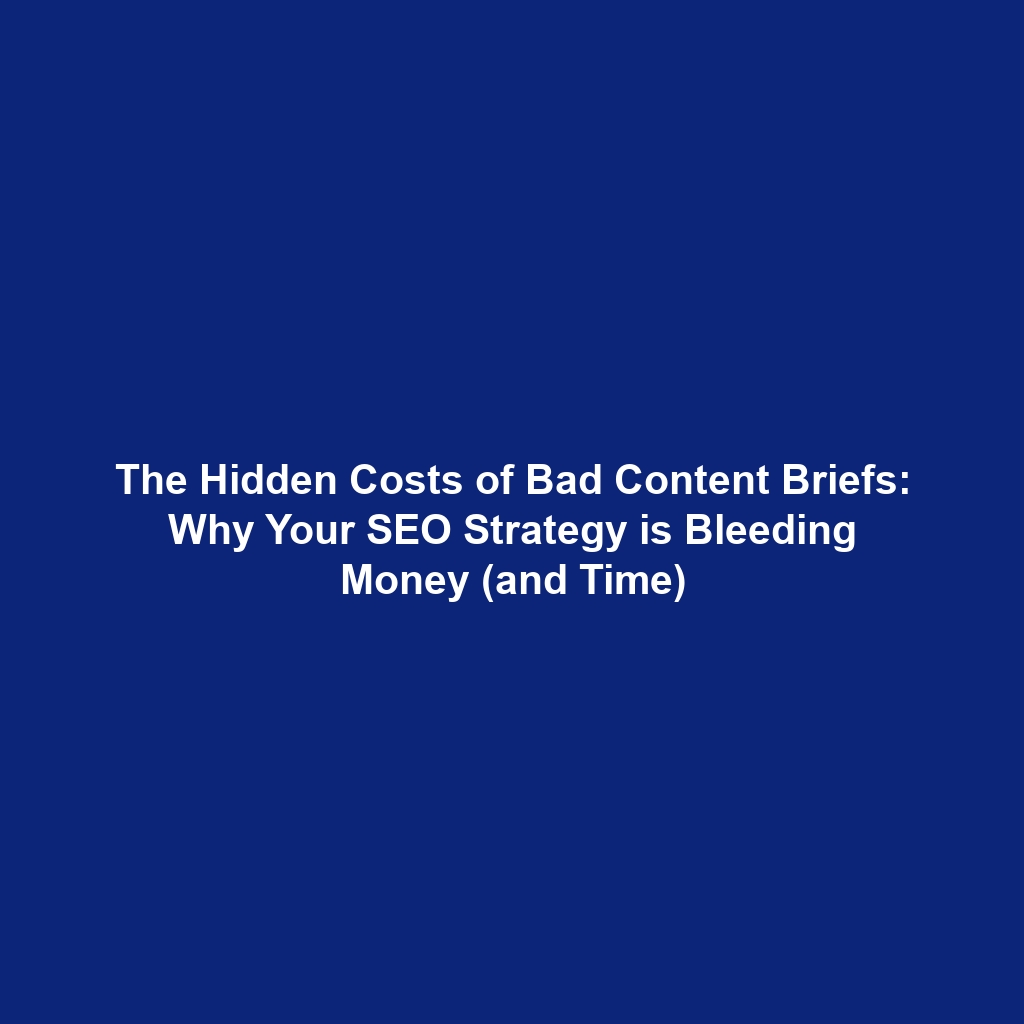Why a Content Brief Template is Your Secret Weapon for Content Marketing Success
In the fast-paced world of content marketing, a well-defined strategy is crucial. But even the best strategy can falter without clear execution. That’s where the content brief template comes in. Think of it as the blueprint for your content, ensuring everyone involved – from content marketers and marketing managers to freelance writers and content strategists – is on the same page. This comprehensive guide will explore the essential elements of a content brief template, providing you with the knowledge and tools to create content that resonates with your audience, achieves your marketing goals, and boosts your SEO performance.
A content brief template isn’t just a document; it’s a communication tool, a project management aid, and a quality control mechanism all rolled into one. It sets expectations, clarifies objectives, and provides writers with the necessary context to produce high-quality, relevant content. Without a solid brief, you risk wasting time and resources on content that misses the mark.
The Essential Elements of a High-Performing Content Brief Template
A truly effective content brief template includes several key components. Each section contributes to clarity, alignment, and ultimately, better content. Here’s a breakdown of the must-have elements:
1. Project Overview: Setting the Stage for Success
This section provides a high-level overview of the content piece. It answers the fundamental questions: What are we creating, and why?
- Project Title: A concise and descriptive name for the content piece.
- Project Goal: What do you hope to achieve with this content? Examples include increasing brand awareness, generating leads, driving website traffic, or improving search engine rankings. Be specific and measurable.
- Target Audience: Who are you trying to reach? Define your ideal reader, including their demographics, interests, pain points, and level of knowledge. Consider creating a buyer persona to bring your audience to life. Refer to resources like HubSpot’s Make My Persona tool for assistance.
- Content Type: Specify the format of the content (e.g., blog post, infographic, video script, ebook, social media update).
2. Content Details: Defining the Scope and Structure
This section dives into the specifics of the content itself, outlining its structure, key topics, and desired tone.
- Topic: The main subject matter of the content.
- Keywords: Include primary and secondary keywords to optimize the content for search engines. Conduct thorough keyword research using tools like Ahrefs Keywords Explorer or Moz Keyword Explorer.
- Search Intent: What is the user hoping to find when searching for the target keywords? Understanding search intent is crucial for creating content that satisfies the user’s needs. Is it informational, navigational, transactional, or commercial investigation?
- Outline/Structure: Provide a detailed outline of the content’s structure, including headings, subheadings, and key talking points for each section. This ensures a logical flow and helps the writer stay focused.
- Word Count: Specify the desired length of the content.
- Tone and Style: Define the desired tone and style of the content (e.g., formal, informal, humorous, informative, authoritative). Provide examples of existing content that exemplifies the desired tone.
- Call to Action (CTA): What action do you want the reader to take after consuming the content? Examples include subscribing to a newsletter, downloading an ebook, requesting a demo, or contacting sales.
3. SEO Requirements: Optimizing for Search Engine Visibility
This section outlines the SEO requirements for the content, ensuring it’s optimized for search engine visibility.
- Target Keyword(s): Clearly state the primary and secondary keywords.
- Keyword Density: Provide guidelines for keyword density, ensuring the keywords are used naturally and avoid keyword stuffing.
- Internal Linking: Specify internal links to other relevant content on your website. Internal linking helps improve website navigation and SEO.
- External Linking: Include links to authoritative external sources to support your claims and provide additional value to the reader.
- Meta Description: Provide a suggested meta description for the content. The meta description is a brief summary of the content that appears in search engine results pages (SERPs).
- Image Optimization: Outline guidelines for image optimization, including alt text and file size.
4. Brand Guidelines: Maintaining Consistency and Voice
This section ensures the content aligns with your brand’s identity and voice.
- Brand Voice: Describe your brand’s voice and personality.
- Style Guide: Refer to your company’s style guide for specific writing conventions and formatting guidelines.
- Tone of Voice: Similar to tone and style of content, but more focused on overall brand image and consistency.
- Examples of On-Brand Content: Provide examples of existing content that aligns with your brand guidelines.
5. Resources and Inspiration: Providing Context and Direction
This section provides the writer with additional resources and inspiration to help them create high-quality content.
- Reference Materials: Include links to relevant articles, studies, and other resources that the writer can use for research.
- Competitor Analysis: Analyze competitor content to identify opportunities and differentiate your content.
- Examples of Successful Content: Provide examples of successful content in your niche to inspire the writer.
- Key Messages: Summarize the key messages you want the content to convey.
6. Workflow and Deadlines: Managing the Process Efficiently
This section outlines the workflow and deadlines for the content creation process.
- Assigned Writer: Identify the writer responsible for creating the content.
- Due Dates: Specify deadlines for each stage of the process, including the first draft, revisions, and final approval.
- Submission Guidelines: Outline the format for submitting the content.
- Review Process: Describe the review process and who will be responsible for providing feedback.
Creating Your Own Content Brief Template: A Step-by-Step Guide
Now that you understand the essential elements of a content brief template, let’s walk through the process of creating your own. You can adapt this template to fit your specific needs and workflow.
- Choose a Format: Select a format for your template (e.g., Google Docs, Microsoft Word, project management software).
- Customize the Sections: Adapt the sections outlined above to fit your specific needs. Add or remove sections as necessary.
- Provide Clear Instructions: Write clear and concise instructions for each section, explaining what information is required and why.
- Use Examples: Provide examples of how to fill out each section to avoid confusion.
- Test and Refine: Test your template with a few writers and gather feedback. Refine the template based on their feedback.
- Make it Accessible: Ensure the template is easily accessible to all team members.
Long-Tail Keywords and Semantic Phrases: Boosting Your SEO Performance
In addition to targeting primary keywords, it’s important to incorporate long-tail keywords and semantic phrases into your content brief template. Long-tail keywords are longer, more specific phrases that target niche audiences. Semantic phrases are words and phrases that are related to your primary keywords. These help search engines understand the context of your content and improve its relevance.
Example:
- Primary Keyword: Content brief template
- Long-Tail Keywords:
- Free content brief template for blog posts
- Content brief template example for beginners
- Content brief template for freelance writers
- Semantic Phrases:
- Content strategy
- SEO optimization
- Content marketing
- Editorial calendar
- Content planning
By incorporating long-tail keywords and semantic phrases into your content brief template, you can improve your content’s search engine visibility and attract a more targeted audience.
Content Brief Template Examples: Inspiration for Your Own
To help you get started, here are a few examples of content brief templates you can use as inspiration:
- Simple Content Brief Template: A basic template that covers the essential elements.
- Detailed Content Brief Template: A more comprehensive template that includes additional details and instructions.
- SEO-Focused Content Brief Template: A template that emphasizes SEO requirements.
You can find free content brief templates online by searching for “free content brief template” on Google or other search engines.
The ROI of a Well-Defined Content Brief Template
Investing time in creating a robust content brief template pays off in numerous ways. Here’s a look at the return on investment (ROI):
- Improved Content Quality: Clear instructions and expectations lead to higher-quality content that resonates with your audience.
- Increased Efficiency: A well-defined brief saves time and reduces the need for revisions.
- Better SEO Performance: Optimized content ranks higher in search engine results.
- Enhanced Brand Consistency: Consistent messaging strengthens your brand identity.
- Stronger Team Alignment: A shared understanding of goals and objectives improves team collaboration.
Conclusion: Embrace the Power of the Content Brief Template
The content brief template is an indispensable tool for any content marketer, marketing manager, freelance writer, or content strategist. By investing the time to create a comprehensive and well-defined template, you can unlock the full potential of your content marketing efforts and achieve your business goals. Embrace the power of the content brief template and watch your content thrive.
Remember to continuously refine and update your content brief template based on your experiences and the evolving landscape of content marketing. Stay informed about the latest SEO best practices and adapt your template accordingly. By doing so, you’ll ensure that your content remains relevant, engaging, and effective for years to come.


